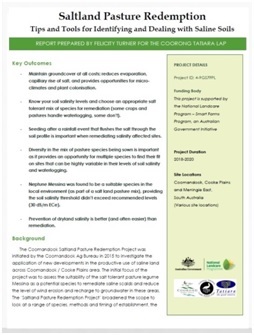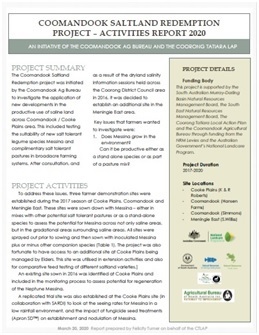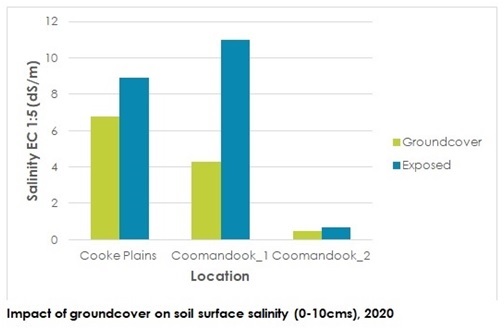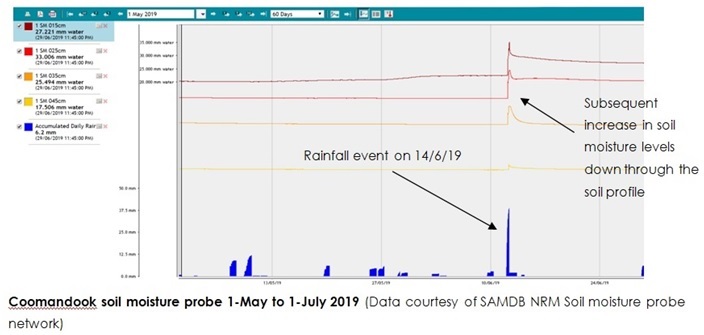Saltland Pasture Redemption Projects
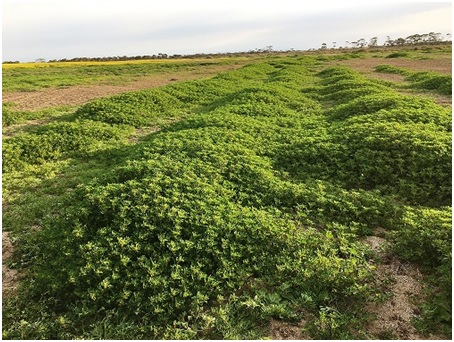
Messina strips - Gypsum Road Cook Plains 2017
To jump straight to information about dryland salinity please click here.
To jump straight to information about salt tolerant pastures please click here.
To learn more about Mallee Seeps please visit the project web site here https://msfp.org.au/mallee-seeps/
To learn more about the Saltland Pasture Redemption Project and related Events keep reading
Use of Remote Monitoring Systems
- to improve knowledge and decision making around dryland salinity management
Programs undertaken by the Coorong Tatiara Local Action Plan have provided opportunities to explore what is and isn’t working in the management of local dryland salinity management systems. As part of this work, several observations have been made by farmers around the seasonal conditions that appear to improve results when remediating soils. In particular, the ‘flushing effect’ required by natural rainfall events and the importance of groundcover in these systems.
With funding support from a Landcare Australia - NBN Co Sustainable Agriculture the opportunity arose to utilise automated monitoring equipment to test these observations to measure the depth of the water table, soil moisture levels, soil salinity
levels and environmental conditions in real time at three monitoring sites across the Coorong and Tatiara District Council regions. This data is updated via automated telemetry at Coomandook, Lake Elephant and Mount Charles every 15 minutes and both real time and historical data can be viewed on line. These sites have been selected as they are viewed as ‘transient’ saline sites.
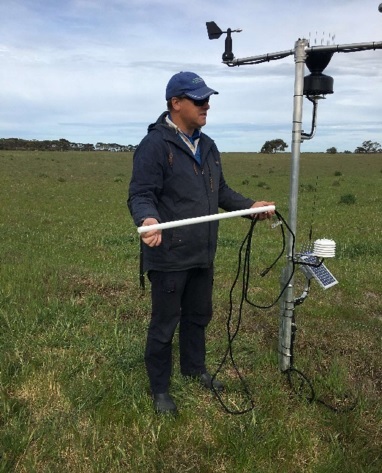
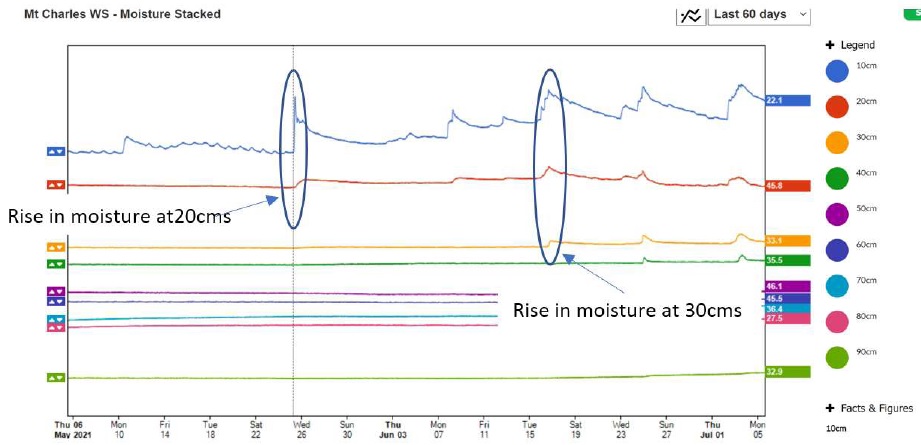
Above left: Shane Oster Alpha Group Consulting installing automated weather station and probe - Elephant Lake 2020
Above right: Example of graph showing stacked soil moisture at Mount Charles June 2021
Initial findings from the information being generated suggest that there are two very different dryland salinity processes that are occurring across the region (even within relatively close proximity of each other). It is hoped that additional funding can be sourced to expand monitoring sites and continue the interpretation of this data into the future allowing farmers to make more informed decisions when managing saline areas (particularly those that are transient and scald one year, but may be back into production in the following year).
Initial findings suggest that knowing the cause of salinity (waterlogging or wicking) has the potential to have implications on the way that the site is remediated and managed. More work is required on understanding how widespread each of the different processes (wicking or waterlogging) are, and if the different processes operate within a local catchment area or if it depends on the location of the site in the landscape.
To view the full Fact Sheet and Technical Report on this work please click here
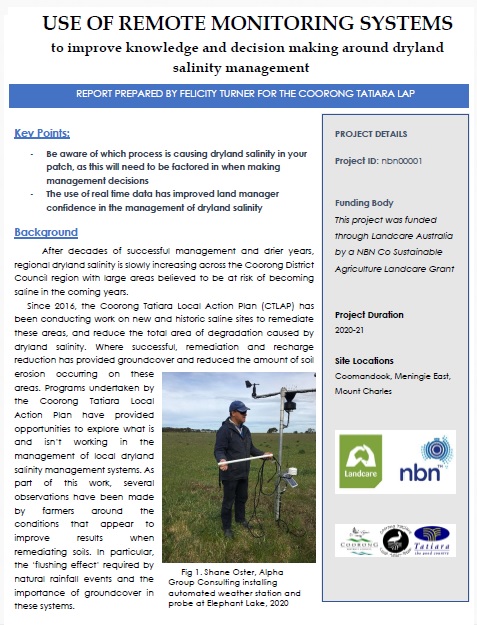
Saltland Pasture Redemption Project
The Saltland Pasture Redemption Group and Project was initiated by the Coorong Tatiara Local Action Plan and Coomandook Ag Bureau to investigate the application of new developments in the productive use of saline land across the Coorong Tatiara. This included testing the suitability of new salt tolerant legume species Messina and complimentary salt tolerant pastures in broadacre farming systems. This project followed on from the Dryland Salinity Information Sessions held across the Coorong District Council area.
In 2016, three sites were established at Meningie East, Coomandook, and Cooke Plains.
Key issues that farmers wanted to investigate were:
1. Does Messina grow in the environment?
2. Can it be productive either as a stand alone species or as part of a pasture mix?
Robust discussion occurred at our Spring 2017 Farm Walk. Producers, Agronomists, NRM & PIRSA Staff, and SARDI Reps were interested in addressing more saltland management questions in regard to establishment, regeneration, and management going forward.
Please click here to access the;
2022 Coorong Saltland Redemption Pasture Report,
2021 Coorong Saltland Pasture Redemption Project Report,
2018 Saltland Pasture Redemption Project Bulletin, and the
Saltland Pasture Redemption Project Bulletin 13th September 2017
With funding support from the National Landcare Program - Smart Farms Program, and Australian Government Initiative the next stage of the Saltland Pasture Redemption Project began in August 2019.
Planning sessions were held in late 2018 and early 2019 with participating landholders, agronomists, seed merchants, and Natural Resources SA Murray Darling Basin and South East to establish 8 demonstration sites to tackle the following saltland agronomy challenges;
- Staggered seeding of salt tolerant legume Messina after several rainfall events (to test effect of rainfall flushing the topsoil)
- Use of groundcovers to test reduced salinity evapo-concentration over the summer period
- Use of mounds and mechanical intervention to enhance establishment (microclimates)
- Establishment of new varieties in existing salt tolerant pasture stands
- Demonstration on a range of soil types
To read the Final Report summarising the findings of the Saltland Pasture Redemption Project please click here ‘Saltland Pasture Redemption – Tips and Tools for Identifying and dealing with Saline Soils’
To read a record of the Saltland Pasture Redemption Project activities from 2017 to present day please click here to access the TECHNICAL NOTE Saltland Pasture Redemption Project Activities 2017-2020
For a summary of the outcomes from this project please read on.
1. Use of groundcovers to test reduced salinity evapo-concentration over the summer period
Throughout the life of the project, the areas where successful establishment of pastures on saline soils occurred were
those where there was evidence of groundcover (green or dead plant material) or areas where the surface was slightly elevated.
We observed retaining some level of groundcover over the summer period may assist in shading the area and reducing the evapo-concentration of salts in the soil over the summer period.
In 2019-20 three sites were monitored to see if groundcover over the summer period provided any benefit to reduce the evapo-concentration / soil wicking of salt to assist in providing a less saline growing environment. Soil samples were taken on the 30th of January 2020 prior to a rainfall event.
The results can be found in the report ‘Saltland Pasture Redemption – Tips and Tools for Identifying and dealing with Saline Soils’ where it can be seen that the groundcover appeared to reduce the soil surface salinity levels across all sites both at the soil surface further down the profile emphasising the importance of trying to retain groundcover to reduce the level of salt scalding.
2. Staggered seeding of salt tolerant legume Messina after several rainfall events (to test effect of rainfall flushing the topsoil)
The time of sowing is critical in trying to remediate saline country. To improve the chances of plant germination, a ‘flush’ is thought to be required. In 2017-2018 this ‘flush’ wasn’t received and there was poor germination across all sites. In 2019, exceptional germinations were observed on hostile, saline soils. The late time of sowing paired with the salts being flushed through the soil was thought to be the key difference driving this success.
Rainfall records against sowing times were monitored across the 8 project sites and compared with soil moisture probe data at Moorlands and Coomandook.
Being able to graphically correlate the soil moisture probe data to what we were observing on project sites was encouraging, and supported the hypothesis that soil flushing was indeed important to improve the outcome of seeding salt tolerant pastures.
This was further supported by the Moorlands soil moisture probe data where the 2018 and 2019 data can be
compared. There was very little change in soil moisture levels from the 25-May to 25-June
2018, with the 50cm zone actually drying out further. This is in contrast to 2019 where there was an
increase in the soil water through the profile down to 50cms.
3. Use of mounds and mechanical intervention to enhance establishment (microclimates)
Throughout the project, different seeding techniques were used with varying success. The common method of seeding into the furrow and then providing a furrow with the press wheel was found to be detrimental to establishment of pastures in saline soil as the press wheel tended to create soil surface sealing impacting on germination. Those seeds that weren’t placed in the base of the furrow rather on the sides of the furrow were those that germinated more effectively (and were more likely to survive).
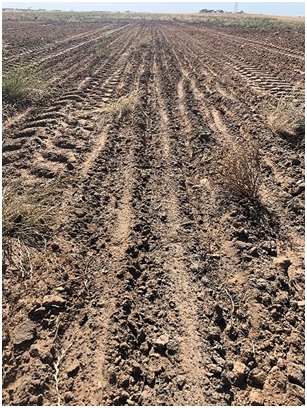
Paddocks that were very roughly worked were those that appeared to have improved establishment
Mounding of a site at Coomandook in 2019 did not appear to improve establishment, however the time of sowing was very delayed at this site and may have required more rainfall to flush the salts out of the mounded area. This site will continue to be monitored as future opportunities allow.
In 2019, a paddock at Cooke Plains that had been impacted by salt since 2013 was deep ripped to 400mm in a series of strips to see if cracking open the soil or reducing a hard pan layer had an impact on the soil salinity levels and establishment of pasture species. A mixture of crop and pasture species was then sown 11th June 2019 across the site.
The ripping was very successful in improving the pasture production and overall health of the plants. Establishment of the small seeds in the mix was reduced (thought to be due to seeding depth on the soft ripped area). Ripping was also effective in decreasing the salinity levels in the treated area, both at the surface, and at the 10-30cm layer.
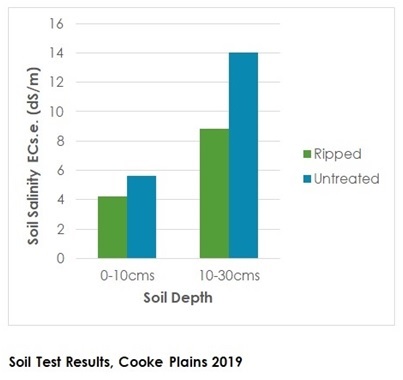
4. Establishment of new varieties in existing salt tolerant pasture stands
There is a wide range of tolerance of different crop and pasture species to soil salinity. The recently released salt tolerant legume Neptune Messina is adapted to winter-waterlogged areas where soil salinity in the top 10cms is 8-30 dS/m ECe in summer-early autumn (https://www.agric.wa.gov.au/neptune)
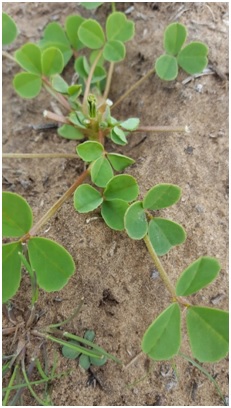 Left: Seedling Messina
Left: Seedling Messina
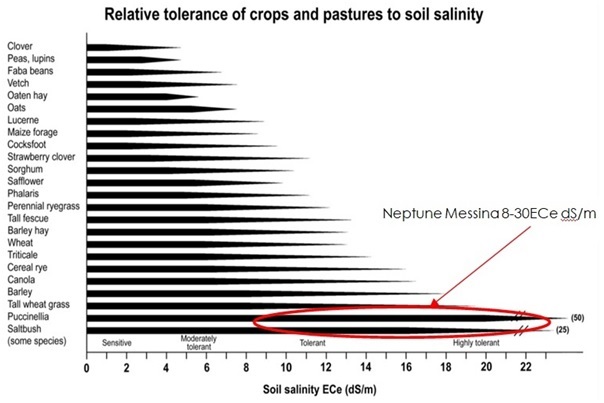
Above: Relative tolerance of crops and pastures to soil salinity (Hermann, 1995)
Farmer demonstrations from 2017-2019 largely focused on the new salt tolerant (and waterlogging tolerant) pasture legume Neptune Messina. It was assessed in different soil types and situations as both a stand-alone salt tolerant pasture, and as part of a saltland pasture mix where it’s role was to add protein to the feed mix and to provide nitrogen to the system (all seed was inoculated with the salt tolerant Rhizobium strain for Messina).
Feed quality samples were taken from the Cooke Plains 2 site in 2017. This testing found that the Messina was comparable in feed quality to other legume species, however farmer experience has been that in larger paddocks with a mixture of soil types and pasture species the Messina can remain largely ungrazed, but still provide valuable groundcover. In the absence of other feed sources, the stock will graze it.
Nodulation of the root system of Neptune Messina was still evident in 2019 in a four-year old stand showing the ability of the rhizobia to survive in the hostile soils in the district.
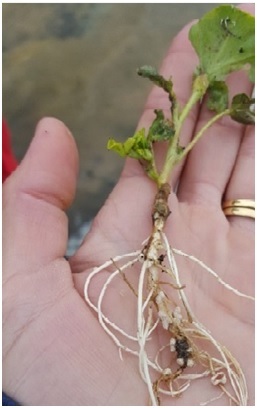 Left: Nodulation of Messina
Left: Nodulation of Messina
The persistence of the Messina and Rhizobia over four years has shown the role that the Messina is likely to play in saltland pastures;
- As part of a diverse species mix (as opposed to a monoculture)
- As part of a mixed salt tolerant pasture sward providing maximum levels of groundcover and water extraction across the saline area
- Providing the vital role of a salt tolerant legume (other than Balansa or Persian Clover) to provide nitrogen fixation in a salt tolerant pasture mix.
This information is explained more fully in the report ‘Saltland Pasture Redemption – Tips and Tools for Identifying and dealing with Saline Soils’.
5. Demonstration on a range of soil types
As the water table below the surface rises, it brings with it dissolved salts to the root zone of crops, pastures, and native vegetation and potentially the soil surface. The first areas affected are often the low-lying areas within paddocks.
There appears to be two main processes occurring across the region leading to soil salinity;
- Discharge - where the water table intercepts with the ground surface creating an area that becomes waterlogged over a period of time
- Capillary action (‘wicking‘) - where evaporation at the soil surface draws the water up through the soil. Capillary action is strongly influenced by soil type with water moving most easily through clay soils and less so through sandy soils making clay soils with a similar water table level more prone to salinity scalding.
Throughout the life of the project, various observations have been made by farmers around those areas that become saline over recent years.
These include;
- Annual Ryegrass (ARG) appearing in low lying areas.
- High biomass production in the year prior to dryland salinity appearing.
- Rapid increase in soil salinity level.
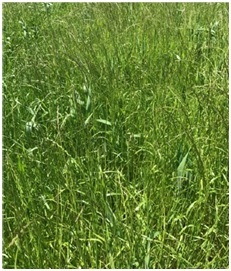 Left: Annual Ryegrass in a waterlogged area
Left: Annual Ryegrass in a waterlogged area
Saltland tolerant pasture establishment was undertaken on a range of soil types as part of this project. The key differences between soil types in terms of saline sites was that the salt ‘wicked up’ to the surface more readily under clay / heavy soils than sandy / light soils. However during this project it was the level of soil salinity and growing season rainfall, regardless of soil type, that were the limiting factors that determined the success or failure of seedling germination.
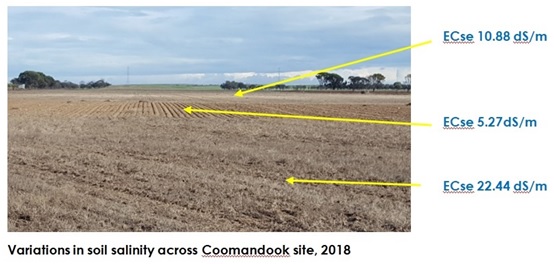
To read the Final Report summarising the findings of the Saltland Pasture Redemption Project please click here ‘Saltland Pasture Redemption – Tips and Tools for Identifying and dealing with Saline Soils’
To read a record of the Saltland Pasture Redemption Project activities from 2017 to present day please click here to access the TECHNICAL NOTE Saltland Pasture Redemption Project Activities 2017-2020
Saltland Pasture Redemption Project Events, Tour Booklets and Presentations
Several events were held over the life of the Saltland Pasture Redemption Project visiting demonstration sites and promoting project outcomes. Some of these Tours, Farm Walks and Workshops were held in conjunction with other projects to bring maximum value to participating land managers.
Please find a summary of events and supporting information below.
The Coorong Tatiara Local Action Plan look forward to more information sharing opportunities in the future.
Carbon on your Farm - Soil Health & Salinity Update
On Wednesday 6th of April 2022 this event was held with 25 participants in attendance.
The day included sessions on;
- A data update from the Roby Downs – Automated Weather Station / Soil Probe / Groundwater Piezometer with Independent Advisor Felicity Turner
- Three Soil Pits across Soil Types. Looking at soil tests results & interpretation, production limitations, dryland salinity, soil carbon, non wetting sands & management options with Brian Hughes - Principal Land Management Consultant with PIRSA
- An overview of carbon flow in local farm businesses in our landscape
- Soil, Carbon and Productivity, Soil Carbon Baseline Levels, Carbon Building Projects in SA. Where to from here? presented by Amanda Schapel, Senior Land Management Consultant with PIRSA. Click here to access this presentation.
- Climate knowledge and local seasonal variability with Darren Ray - Applied Consulting Climatologist
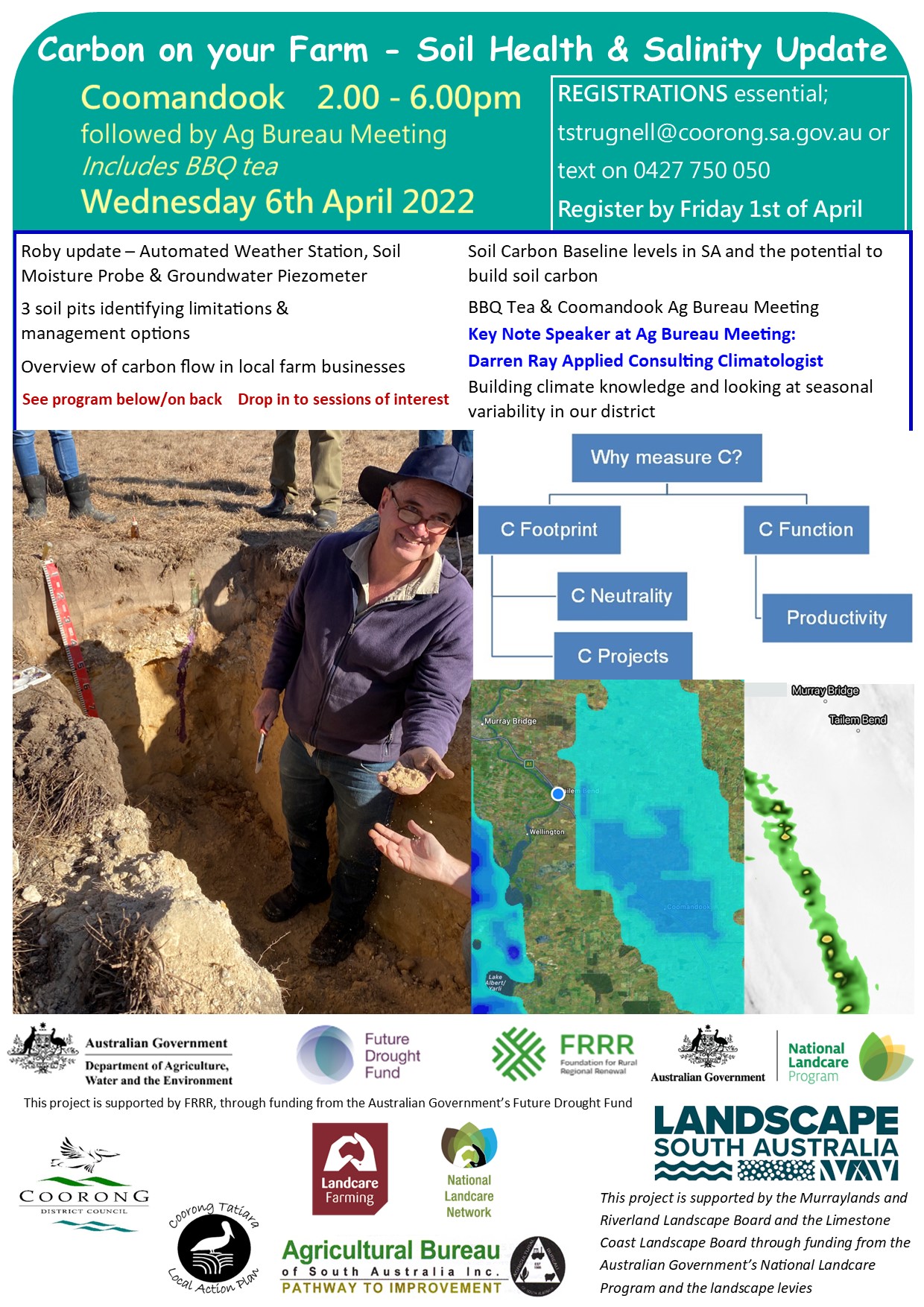
Please click here to access the Information Booklet from the day
Below top: The group listen to Brian Hughes of PIRSA discuss overcoming soil constraints including dryland salinity
Below bottom: Amanda Schapel of PIRSA speaks to to group about Soil Carbon and Productivity
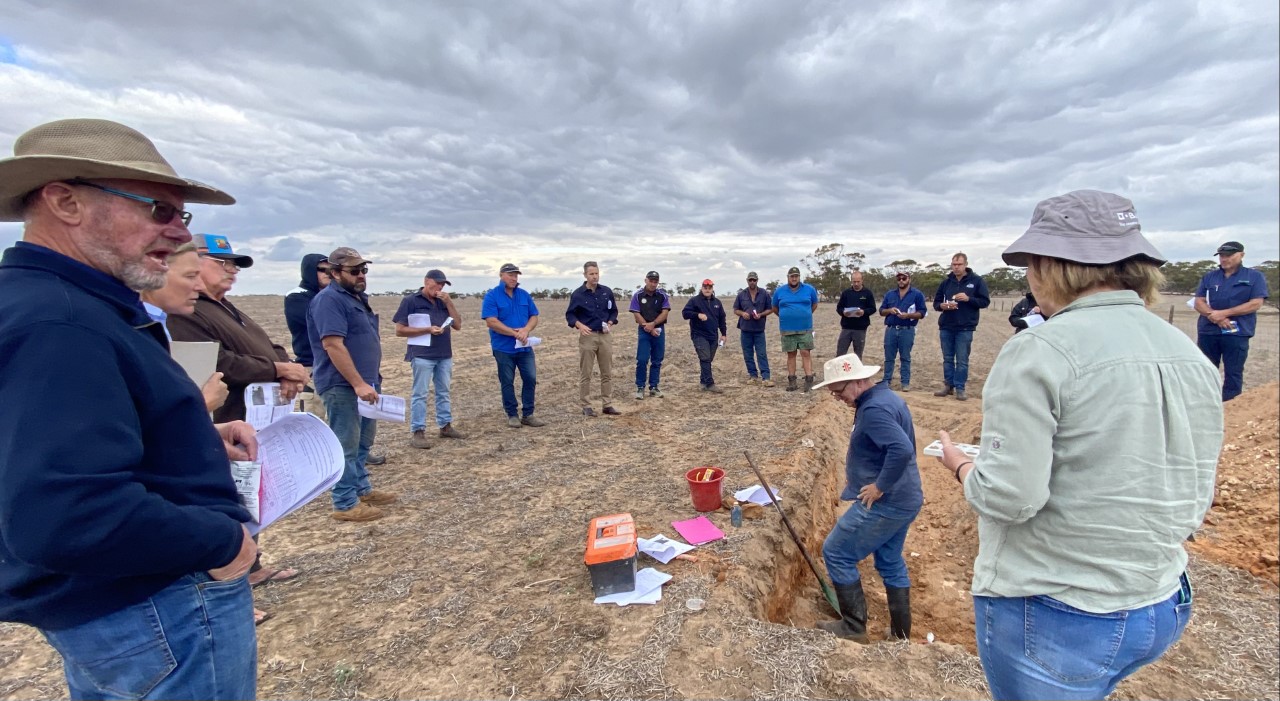

Soils, Carbon & Productivity, Mt Charles & Keith - Farm Walk and Workshop
On the Friday 29th October 2021 a high quality event was held looking at a range of topics of relevance to agriculture across the Tatiara and Coorong with 55 participants in attendance.
The day included sessions on;
- Carbon in your farm business. Looking at carbon footprints, emission reduction & sequestration options, and looking at whether we can we build soil carbon in our landscape. Click here to access the presentation.
- Applying the data - Telemetry for weather, soil moisture, groundwater, & salinity. Click here to access the presentation.
- Soil pH trends across the Tatiara and Coorong. Impacts on yield & feed growth. Economic treatments to overcome acidity. Click here to access the Fact Sheet and Report: Soil Acidity in the Coorong and Tatiara Districts.
- Learning about the Bednar Terraland deep ripper delver incorporator with crumbling roller up close, and learn about its optimum uses and benefits.
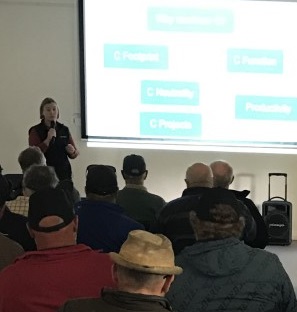
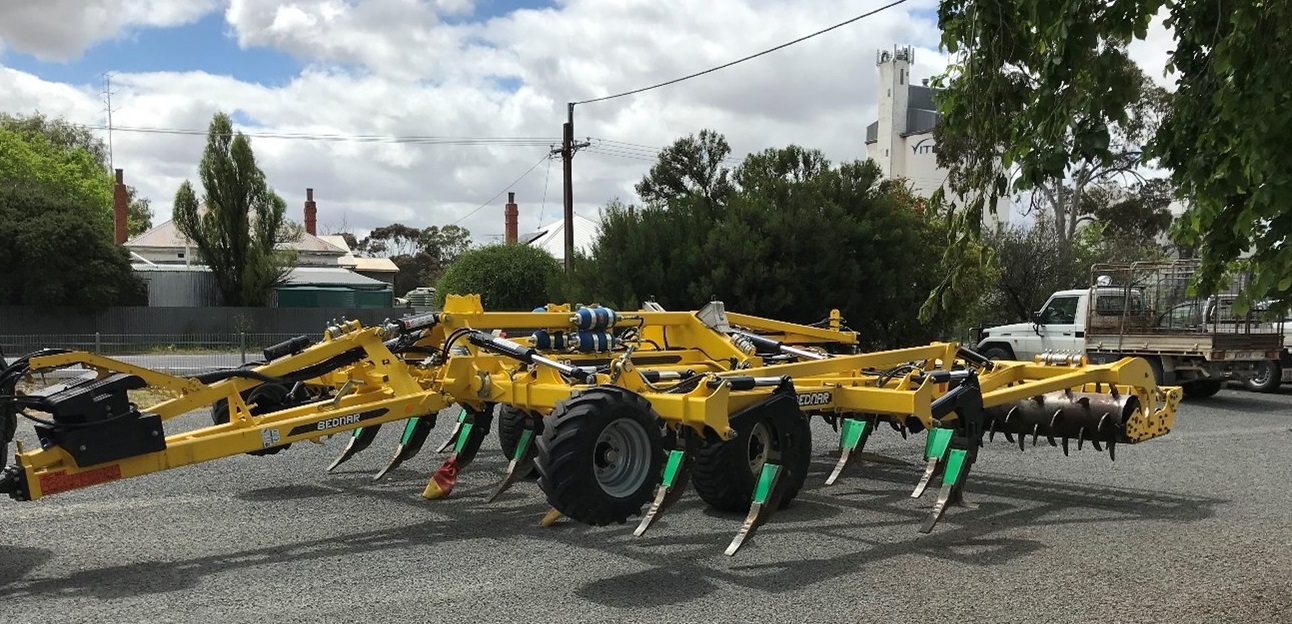
Above top: Amanda Schapel of PIRSA presents to the group at the Keith Institute
Above bottom: Bednar Terraland deep ripper delver incorporator with crumbling roller
The morning farm walk component at Mount Charles included a technical soils session looking at three soil pits across the landscape identifying limitations to plant growth, and best bet amelioration treatments, and looking at telemetery equipment in the field.
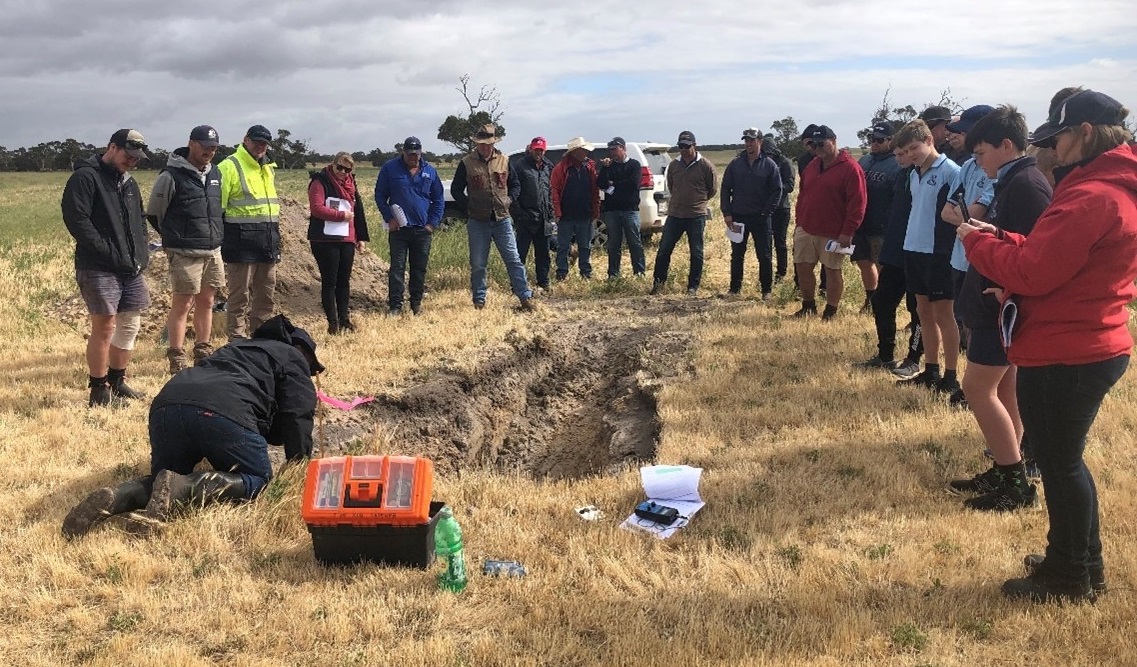
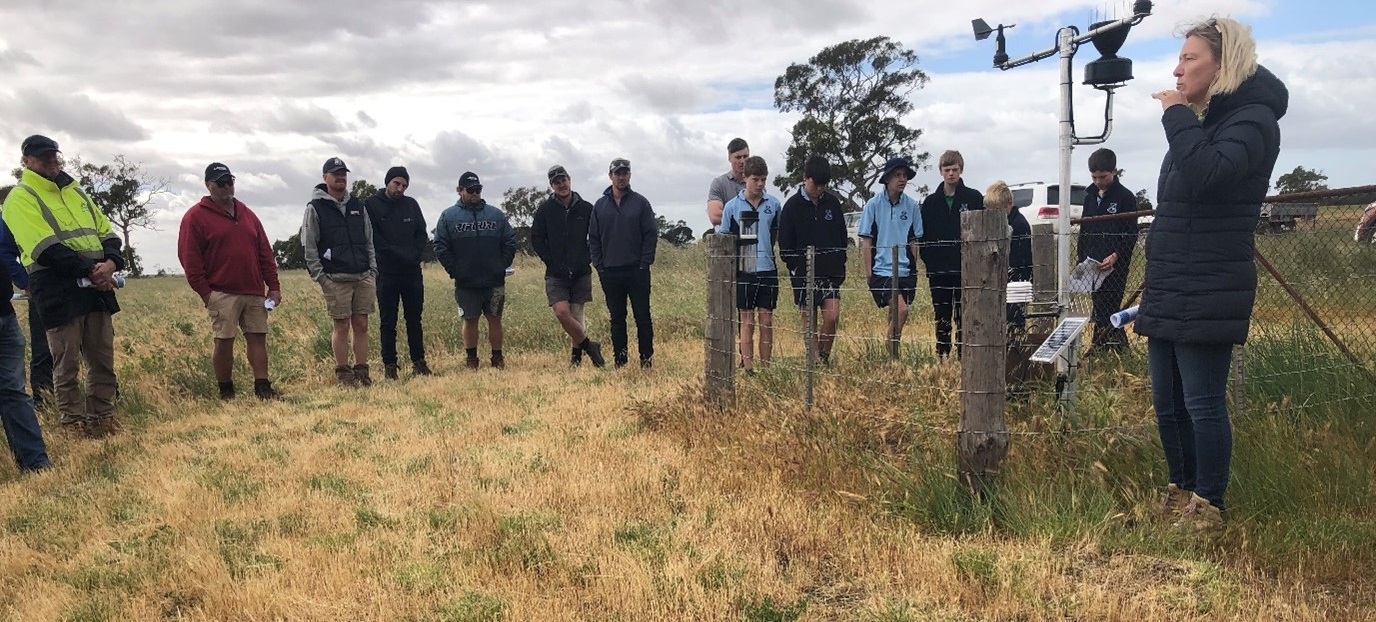
Above top: Brian Hughes of PIRSA at the soil pit identifying limitations to plant growth
Above bottom: Independent Advisor Felicity Turner explains on farm telemetry equipment
Expert speakers on the day included;
Brian Hughes, Amanda Schapel & Andrew Harding - Land Management Consultants from PIRSA covering carbon in your farm business and soil carbon, identifying and overcoming soil limitations to production, and soil pH impacts on yield and plant growth
Felicity Turner – Independent Advisor, covering optimum use of on farm telemetry equipment, and using this data for seasonal decision making
Simon March –EarthServ Pty Ltd, showcasing the Bednar Terraland deep ripper delver incorporator with crumbling roller
Please click here to access the technical notes handed out on the day.
Funding and support for this event was provided by the Limestone Coast Landscape Board through funding from the Australian Governments National Landcare Program, Coorong and Tatiara District Councils.
Sandy Soils and Saltland Pasture Redemption Tour
Wednesday 2nd of October 2019
This tour was held on Wednesday the 2nd of October between 2pm and 6pm.
Covered on this day was:
- Deep ripping salinity affected ground
- Shot gun pasture/crop mixes on saline ground
- Fourth year regenerating Messina
- Salinity tolerance of crop & pasture seedlings in the Waite Plant Accelerator.
To access the Flyer, Program and Tour Booklet please click here.
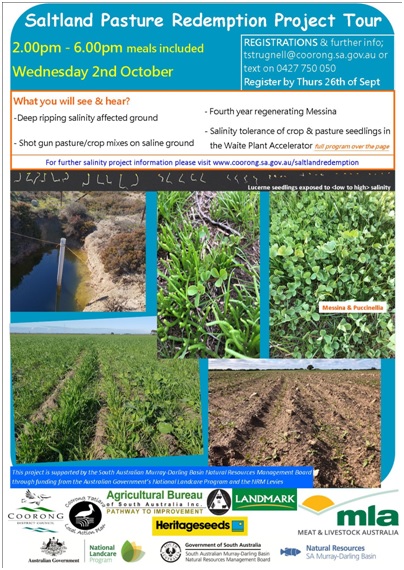
Dryland Salinity and Hydrogeology Update & Local Salinity Trends
Thursday 28th of March
The information covered at this update had a particular focus on the Coomandook, Cooke Plains, and Meningie East localities.
Covered during the session was; a history of dryland salinity, hydrogeology update, overview of the Saltland Pasture Redemption Project, and a discussion as a group around where to from here.
Please click on the links below to access the presentations, and 'where to from here' discussion outcomes.
1. A Local History of Dryland Salinity with Graham Gates - Coorong Tatiara Local Action Plan
2. Groundwater Monitoring Update with Chris Henschke - Rural Solutions(1280 kb)
Fact Sheet - Lower Lakes and Dryland Salinity
4. Saltland Pasture Redemption Project Update with Felicity Turner - Coorong Tatiara LAP
5. New Perennial Legume Pasture - Tedera with Robert Christie - Seednet
Where to from here discussion outcomes
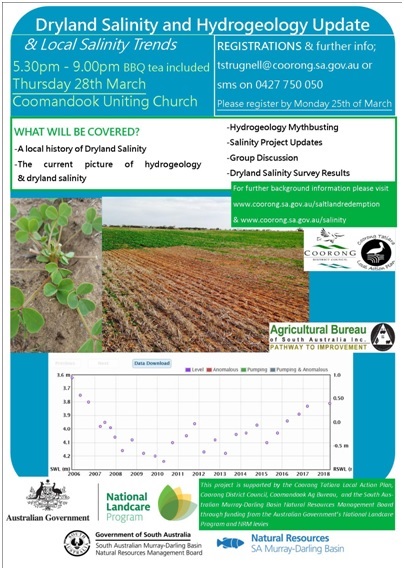
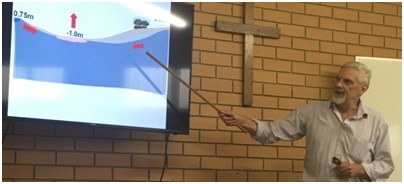
Above: Steve Barnett from the Department for Environment and Water presenting on regional hydrogeology
Meningie East / Field - Crop & Pasture Walk
This tour was held on Thursday the 27th of September 2018 touring sites around Meninge East & Field. To access the Tour Booklet and additional handouts from this and the associated Coomandook Tour please click on the links that can be found below.
TOUR BOOKLET Meningie East Field Crop & Pasture Walk 27th September 2017 (8123 kb)
(8123 kb)
Groundwater Trends Coomandook_Meningie (773 kb)
(773 kb)
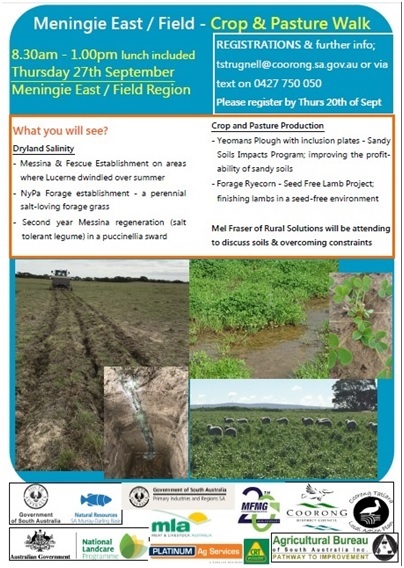
Saltland Pasture Redemption Project Site Tour & Local Salinity Trends 2018
This tour was held on Wednesday the 19th of September 2018 touring sites around Coomandook and Cooke Plains. To access the Tour Booklet and additional handouts from this Tour please click on the links below.
TOUR BOOKLET Saltland Pasture Redemption Project Site Tour 19th September 2018 (9345 kb)
(9345 kb)
Lanza Tedera herbaceous drought tolerant perennial pasture legume for mediterranean environments
Trends in Dryland Salinity across SA (267 kb)
(267 kb)
Summary of treatments applied on Gypsum Road Demonstration Site - Paul Ruchs Landmark (3770 kb)
(3770 kb)
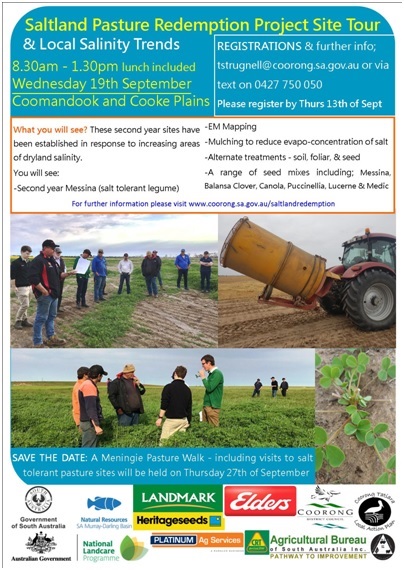
A Planning Forum was held in March 2018 with participating landholders, agronomists, seed merchants, and Natural Resources SA Murray Darling Basin and South East. The outcomes and outlines of site plans for 2018 are contained in the report below. Relevant data from the 2017 season in contained in the presentation below.
PLANNING FORUM REPORT Saltland Redemption Project March 20th 2018 (1391 kb)
(1391 kb)
Saltland Pasture Redemption Update Presentation 20th March 2018 (966 kb)
(966 kb)
Below: Tomohawk Bale Shredder used to spread mulch at Cooke Plains
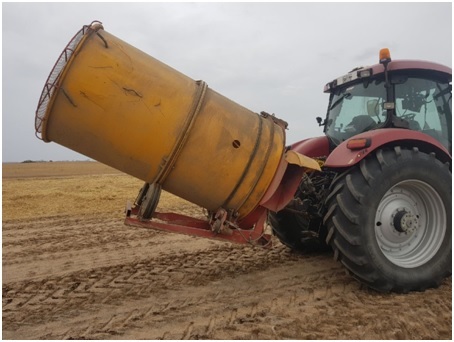
Saltland Pasture Redemption Site Tour 2017
The first Saltland Pasture Redemption Site Tour was held on Wednesday the 20th of September 2017 with approximately 60 landholders, agronomists, NRM, PIRSA and SARDI staff in attendance. It was a terrific opportunity for a cross fertilisation of ideas.
With funding secured to run this project over another season several ideas were discussed about what aspects of saltland pasture and messina establishment we should look at next such as;
Seeding Messina into established Puccinellia pasture | Timed seeding of Messina after several rainfall events |
Use of ground covers to stop salinity concentration such as; Plastic / Organic mulch / Groundcover | Messina palatability |
Messina response to nutrients and trace elements | Use of raised seed beds or mounds |
Comparing innoculated vs un-innoculated Messina | Your idea? |
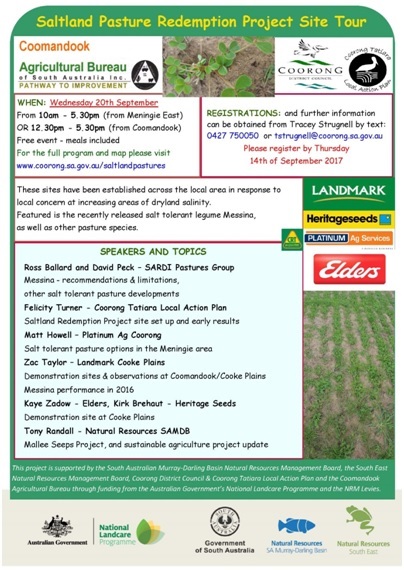
Below is a range of information from the day including; the tour booklet, various papers and fact sheets, and presentations from SARDI and Natural Resources SA Murray Darling Basin.
Tour Booklet - Saltland Redemption Farm Walk 20th September 2017 (15929 kb)
(15929 kb)
PRESENTATIONS
After lunch presentations were given by;
Ross Ballard - SARDI Rhizobiologist, and David Peck - member of the SARDI Pasture Group
Messina - a new annual legume for saltland pastures (4209 kb)
(4209 kb)
Tony Randall - Natural Resources SA Murray Darling Basin, Land & Water Management Team Co-ordinator
Mallee Seeps in the SA Murray Darling Basin NRM Region (1737 kb)
(1737 kb)
MESSINA
Please click here to access a paper by Ross Ballard and David Peck of SARDI 'Messina establishment and management.'
Elders - Heritage Seeds - White Saline Pasture Demonstration at Coomandook - click here.
SOIL TESTING FOR SALINITY
Measuring salinity Understanding the numbers (233 kb)
(233 kb)
Soil Salinity Sampling Fact Sheet (87 kb)
(87 kb)
Soil Salinity ECe crop and pasture tolerance chart (91 kb)
(91 kb)
FEED TEST RESULTS
Messina Feed Test 07.09.2017 (87 kb)
(87 kb)
Scimitar Burr Medic Feed Test 07.09.2017 (81 kb)
(81 kb)
For more Saltland Pasture information and Fact Sheets that were produced to cover conditions in our region please click this link to return to our Saltland Pastures web page by clicking here.
For more information on this project please contact tstrugnell@coorong.sa.gov.au


![]()
![]()

